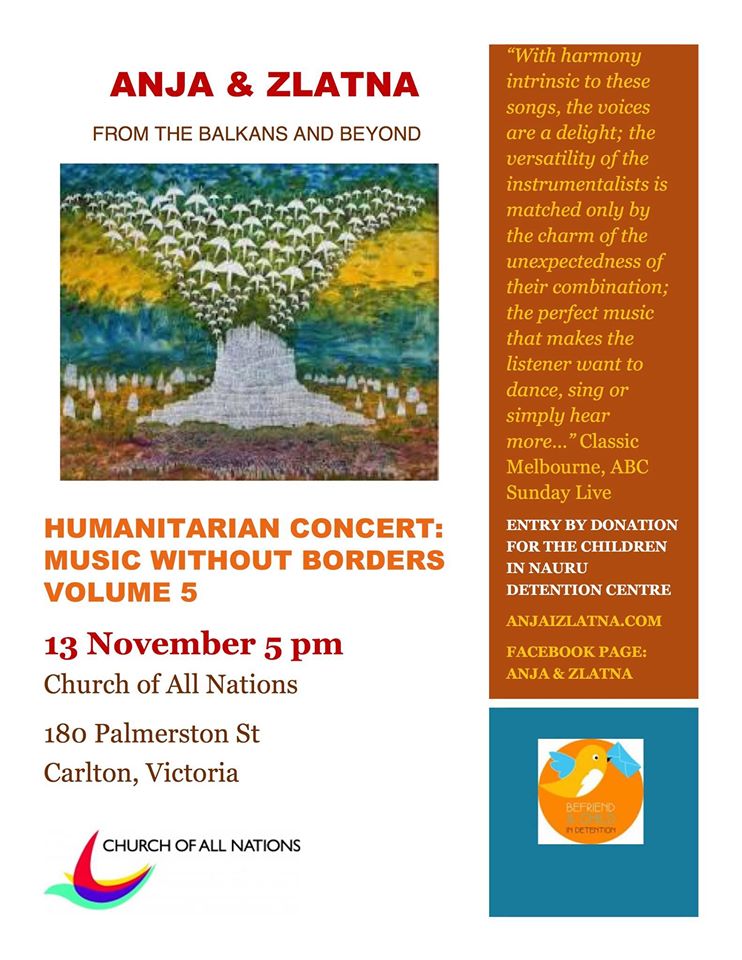Spring 2016
| Mark the Evangelist Futures Project |
Mark the Evangelist Futures Project I suggested a year ago that, “Perhaps the trick in negotiating what is ahead of us will be this: to engage not in dreary property development or divestment but in a joyful work of love in God’s garden.” It’s not been quite the work of love I proposed then that it might have been; there has been a bit more of the dreary than of the joyful. Or, at least, so it has seemed to me. As things begin to take shape and we approach a time of decision, one thing which seems to be becoming clear is that there may be many respects in which MtE’s future will not look like some of our more hopeful visions. Significant compromise may turn out to be the order of the day. Compromise often feels like accepting the lesser of two goods: the good we desire giving way to the good we can actually get. Compromise can have more the feel of the dreary than of the joyful. The question becomes, Where in this might joy be found?
It is difficult, without particular scenarios in front of us, to be more specific about what choices we might face and to think through their consequences; and those scenarios are not finalised for presentation in detail here for reflection. But what is clear is that we should be prepared for the future to differ considerably from the past. This need not be a bad thing; it is at least a real thing. And here there is hope, because the real is the place in which God is to be met, and not in memories of what has been or dreams or visions of what might have been, as important as they may have been to this point. Where we end up will be quite specifically our place because it will be the place where God meets us, and that is what will make it enough for us. How do we move into a different future? Where is joy to be found? In the hope and experience of God working alongside us in his garden. Let our prayer be for this, as we move forward together. Seeing Where We Serve (Editor’s note: We held over this TOUR OF HOTHAM MISSION SITES 17/4/2016 wanting to find the right time to publish it, which is now. Thanks also to Rob for the great pictures placed throughout this item.) Actually there were two buses. Enthused by the Board chair, Gaye Champion, who introduced the Hotham Mission projects and principles of early intervention, we set out to see for ourselves. First we passed the old Manse, with its free accommodation for asylum seekers. One of them was actually in a bus. The North Melbourne Police Station in Wreckyn St is quite close to the Church. They have a community liaison officer, Nick Paressis, who supports the Mission projects, and helps with BOLT (explained later). In return, Hotham Mission sponsors the Police-run Holiday Program for kids in difficulties about to start High School.
Mt Alexander College was a stop as it has become a major focus of our work – and the Principal writes glowing letters in appreciation, commending the programs. The College has 350 secondary students and is possibly the most disadvantaged school in Victoria. Here some children are homeless, some arrive hungry, and others lack uniforms, books and equipment. Some of our party talked about bringing up their own children here. It was a lovely autumn day, and a picnic atmosphere developed as people from four churches chatted to each other about what we were seeing.
In the buses Project Manager, Beth Stewart-Wright, and Executive Officer, Greg Hill, talked about work in the neighbourhood. We passed Christ Church Kensington, which is near Kensington Neighbourhood House where we support classes for migrants learning English. Next door to the Church is Kensington Primary School. Work is done here with children who are about to go to secondary school, but don’t want to. BOLT MEANS “Bikes Over Lunch Time”. Each student referred by the school is given an old bike to fix up. If they can get it going, they can keep it. While they work they are supervised, and the conversation cavers far more than repairing bikes. Attitudes, aggressions and anxieties are worked through with trained counsellors. Policemen help and become friends.
“Oops”. We’re overtime. Several people are anxious about being late for another appointment. Our bus detours and drops some off to save time. The rest of us return to Mark the Evangelist, congratulate each other on an hour well spent, and head off for a late lunch. Lend me your ear (Editor’s note: In talking about spaces for worship it’s all too easy to forget important details, such as the acoustics! Mary addresses a problem which has been evident as we experiment with seating plans and mikes.) It has been suggested that I write a few words about my Hearing Aids’ accessories. As I find it very difficult to hear the spoken word in our church services I bring along my special little microphone which I put under the lectern, which works in conjunction with a receiver worn around my neck which in turn connects wirelessly with my hearing aids. This device is not perfect because it also picks up the loud speakers and the echo in the building but it is certainly very helpful. As I put the microphone under the lectern it does shield it a little from the echo. These accessories were suggested by my audiologist. They were not cheap, but do help a lot in different situations. Audiologists usually allow one to try these devices to see if they are helpful before committing to buy them. There is a range of microphones, some are pencil-shaped and can be handed around a table to the speakers so the deaf person can hear the speaker. Mine is a small device which I fix with Blu Tac under the lectern. It can also be put on a speaker’s lapel for a close conversation, or can be left by the TV set so the volume does not have to be on full blast. I am always hoping something better will be invented in the near future. I saw the film Spy in the Sky where an insect-size drone could pick up both sound and pictures! It would be good if there was such a device for us who wear hearing aids, we only need the sound part. Planning for the future (Editor’s note: Fred Batterton is an architect whose special interest is in the re-purposing of church buildings for the 21st century, and the options open to decision-makers. We should be making buildings that are adaptable. We should take time to think ahead. Look at what has changed in the past 50 years and expect it to change as much again in the next 20 due to accelerating pace of change. Ask what is the building or land for? Apart from shelter and comfort from extremes of climate it will be a refuge and a venue for relationships. It is also an expression of what is meaningful to us. This may include the heritage that we have from those who’ve been before us. 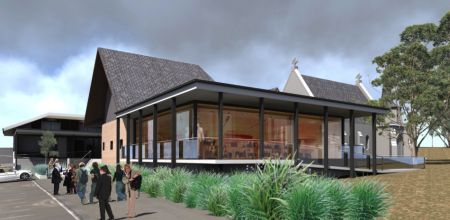 St John’s Highton has a long-term masterplan to add a cafe on its street frontage to create an immediate connection to the public who visit nearby facilities like the kindergarten and bowls club. This is planned to be attractive, transparent easily accessible. Image: Fred Batterton, Studio B Architects Our buildings will be places for different activities: work, play, living, learning, manufacturing, watching, exercising, worshipping, talking, performing, supporting, contemplating and praying. All based in mission. What do we risk without a master plan?The risk is that valuable funds will be spent on an item of property that may be in the wrong place for the future. It could then stand as a barrier to achieving long-term mission goals because no one wants to undo the work that has been done with the best of intentions. Fred has written a series of newsletters on this and related subjects. You can find them at www.studiob.net.au/recognition/lateral-thinking News From Church Council Matters around the Mark the Evangelist Futures Project have comprised the larger part of Church Council business in recent months, yet I won’t attempt to summarise them here, since they have been so thoroughly presented in various documents for the attention of the Congregation at periodic intervals. However, I do want to acknowledge the remarkable commitment and dedication of our Church Councillors who are members of the Project Control Group (PCG): Alan, Maureen and Rod. In particular Alan’s work as Project Co-ordinator amounts to that of a part-time equivalent position, involving co-ordination, consultation and documentation. During this time the advice and recommendations of our PCG members have been invaluable to Church Council. Many of you will know from Sunday notices that Maureen was elected Elder for a term of three years and Michael for a term of three years in April. Church Council warmly thanked retiring Elders, Heather Mathew and Wendy Langmore for their long and faithful service to the Congregation. We also acknowledged Heather’s great contribution as co-ordinator of Sunday Conversations for more than ten years, a role that Michael has now taken up. In May Church Council elected its office-bearers: Tim was re-elected Chair, Rod Deputy Chair, Belinda Secretary and Gus Treasurer. Besides the ongoing business of Church Council relating to pastoral care, eldership, ministry and mission, and finance and property, we also received and endorsed a suite of documents from the Synod under the broad heading of Safe Church for the attention of congregations, which allowed us to consider the safety and wellbeing of all persons associated with Mark the Evangelist. In May we were advised of the impending closure in June of the Curzon Street Children’s Centre, which had leased the Supper Room and adjoining rooms for over twenty years. For more than a year before that Church Councillors and members of the Management Committee of the Children’s Centre had met regularly to discuss possible accommodation of the facility, but due to property planning for the Mark the Evangelist Futures Project, the Congregation through the Synod had not been able to offer the Centre a lease beyond 2016. We recognise the contribution that the Congregation has made to families in the North Melbourne community through the lease of the premises over a generation. (Comments, suggestions and queries are welcomed by the Church Councillors: Gaye Champion, Michael Champion, Belinda Hopper (Secretary), Gus MacAulay (Treasurer), Rod Mummery, Tim O’Connor (Chair), Maureen Postma, Craig Thompson (Minister), Alan Wilkinson (Presbytery appointee) and Ann Wilkinson.) Noticeboard 4 September MtE Futures Project Congregational Discussion 23 October MtE Futures Project Congregational Meeting 6 November All Saints Day lunch And finally… |

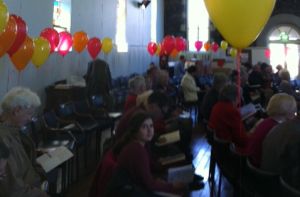 If we are pushed to a point of considerable compromise, it will be important to be able to articulate – for ourselves personally, at the very least – what it is we think matters the most. We know, “theoretically”, that a church is not its buildings. Such “knowledge”, however, is different from actually living in a space which is not “a” church as we imagined it. We know – again, “theoretically” – that a church’s mission is not “programs” but an attending to the world we encounter, as and when we encounter it. And yet, again, such knowledge is different from moving into a form of mission quite different from how we have practised it to date. There is risk, then, in making decisions on the basis of the theory, and then having to live them in practice.
If we are pushed to a point of considerable compromise, it will be important to be able to articulate – for ourselves personally, at the very least – what it is we think matters the most. We know, “theoretically”, that a church is not its buildings. Such “knowledge”, however, is different from actually living in a space which is not “a” church as we imagined it. We know – again, “theoretically” – that a church’s mission is not “programs” but an attending to the world we encounter, as and when we encounter it. And yet, again, such knowledge is different from moving into a form of mission quite different from how we have practised it to date. There is risk, then, in making decisions on the basis of the theory, and then having to live them in practice. It was all out of the bus at St Alban’s Anglican Church. Parishioner and Hotham Mission Board member, Tim Thwaites, introduced us to the Op Shop there. It’s a meeting place for residents of the nearby Hotham Hill flats, and supplies emergency relief, especially for newcomers. Downstairs Dorothy told us about the Food Service and showed us their impressive facilities for storage and refrigeration.
It was all out of the bus at St Alban’s Anglican Church. Parishioner and Hotham Mission Board member, Tim Thwaites, introduced us to the Op Shop there. It’s a meeting place for residents of the nearby Hotham Hill flats, and supplies emergency relief, especially for newcomers. Downstairs Dorothy told us about the Food Service and showed us their impressive facilities for storage and refrigeration. We drove past the YMCA,where the Mission has a Homework Club, and where our minister’s children play basketball. Hotham Mission is helping re-fit the YMCA industrial kitchen so food programs can be expanded. There are hopes for cooking classes, and for teaching residents how they can grow food on their balconies.
We drove past the YMCA,where the Mission has a Homework Club, and where our minister’s children play basketball. Hotham Mission is helping re-fit the YMCA industrial kitchen so food programs can be expanded. There are hopes for cooking classes, and for teaching residents how they can grow food on their balconies.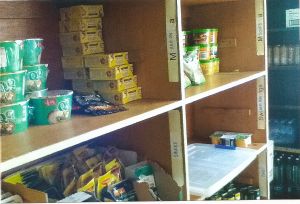 The Mission has developed several ways of distributing food where it is most needed, the MACpack voucher system for example. The Renshaw Bequest provides books and equipment for students referred by the school, but it has run out for 2016 already, and the Mission is refusing requests.
The Mission has developed several ways of distributing food where it is most needed, the MACpack voucher system for example. The Renshaw Bequest provides books and equipment for students referred by the school, but it has run out for 2016 already, and the Mission is refusing requests. Our last stop is Holland Park. We actually got into the Community Centre – what a facility! There is a pool, a gym, a hall, meeting rooms and multiple vending machines. We go into the room where “Mess Club” meets. Beth explained this new program. Students are referred from several schools and community service providers because they are disengaged and appear vulnerable. A skilled supervisor interviews them, identifies a spark of interest and develops a project they can work at overtime and with help. Not only do they discover where to find materials, the importance of figures and measurements, and manual skills, they also come to appreciate the importance of learning and relating. Then they are able to re-engage and progress in their education.
Our last stop is Holland Park. We actually got into the Community Centre – what a facility! There is a pool, a gym, a hall, meeting rooms and multiple vending machines. We go into the room where “Mess Club” meets. Beth explained this new program. Students are referred from several schools and community service providers because they are disengaged and appear vulnerable. A skilled supervisor interviews them, identifies a spark of interest and develops a project they can work at overtime and with help. Not only do they discover where to find materials, the importance of figures and measurements, and manual skills, they also come to appreciate the importance of learning and relating. Then they are able to re-engage and progress in their education.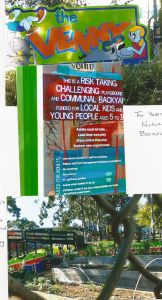 The “Venny” abuts the Community Centre. Its notice board reads: “This is a risk taking, challenging playground … Adults must let kids lead their own play, enjoy active free play and explore new experiences”. We peer through the wire mesh fence and see the children’s garden, adventure playground, and the two shipping containers in which this unique experiment began. Children from the Mess Club go across to the Venny for a nutritious meal one night per week.
The “Venny” abuts the Community Centre. Its notice board reads: “This is a risk taking, challenging playground … Adults must let kids lead their own play, enjoy active free play and explore new experiences”. We peer through the wire mesh fence and see the children’s garden, adventure playground, and the two shipping containers in which this unique experiment began. Children from the Mess Club go across to the Venny for a nutritious meal one night per week.

